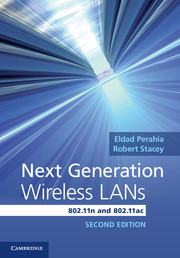Preface to the first edition
Published online by Cambridge University Press: 05 June 2013
Summary
Having worked on the development of the 802.11n standard for some time, we presented a full day tutorial on the 802.11n physical layer (PHY) and medium access control (MAC) layer at the IEEE Globecom conference held in San Francisco in December 2006. Our objective was to provide a high level overview of the draft standard since, at the time, there was very little information on the details of the 802.11n standard available to those not intimately involved in its development. After the tutorial, we were approached by Phil Meyler of Cambridge University Press and asked to consider expanding the tutorial into a book.
Writing a book describing the standard was an intriguing prospect. We felt that a book would provide more opportunity to present the technical details in the standard than was possible with the tutorial. It would fill the gap we saw in the market for a detailed description of what is destined to be one of the most widely implemented wireless technologies. While the standard itself conveys details on what is needed for interoperability, it lacks the background on why particular options should be implemented, where particular aspects came from, the constraints under which they were designed, or the benefit they provide. All this we hoped to capture in the book. The benefits various features provide, particularly in the physical layer, are quantified by simulation results. We wanted to provide enough information to enable the reader to model the physical layer and benchmark their simulation against our results. Finally, with the amended standard now approaching 2500 pages, we hoped to provide an accessible window into the most important aspects, focusing on the throughput and robustness enhancements and the foundations on which these are built.
- Type
- Chapter
- Information
- Next Generation Wireless LANs802.11n and 802.11ac, pp. xix - xxPublisher: Cambridge University PressPrint publication year: 2013



